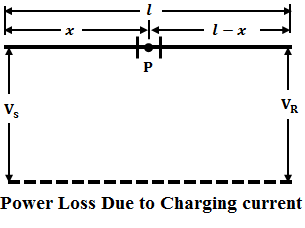We know that a capacitor is formed by separating two conducting materials with an insulating medium in between them. In a similar fashion, a capacitance is formed in between the two conductors of an overhead transmission line, where the atmospheric air present between the conductors behaves as the insulating medium. This capacitance formed between the conductors is distributed all along the length of conductors.
At no-load conditions, the transmission line carrying alternating voltage draws a leading current knows as the charging current. This existence of a charging current is due to the effect of the capacitance of the transmission line.
The charging current drawn is in quadrature with the supply voltage and is independent of the load i.e., the charging current is present even when there is no load connected to the transmission line or open-circuited. The effect of the charging current can be seen only on the transmission lines having a length over 100km.
The charging current drawn by the capacitance of the line depends upon the magnitude of supply voltage, the capacitance of the line, and the operating frequency of the line. Mathematically, it is given as,
Suppose if the effect of capacitance is high on the conductors, the line draws more leading current that cancels the lagging component of the load current i.e., reactive power drawn due to the inductive nature of the load. Hence, the reactive power drawn decreases, which in turn decreases the current flowing in the line.
The decrease in line current in the transmission or the effect of charging current results in,- Increase in the transmission efficiency due to decrease in line losses.
- Reduction of line reactance and also improves the voltage at the sending end side, thereby improving the voltage regulation.
- Compensation of inductive reactive power that increases the load power factor and load capacity.
- Power loss in the line even though the line is open-circuited.
Power Loss Due to Charging Current :
Consider a line of length l km having a charging current Ic at the sending end. Consider a point P at a distance of x km from the sending end of the length l km as shown below.



